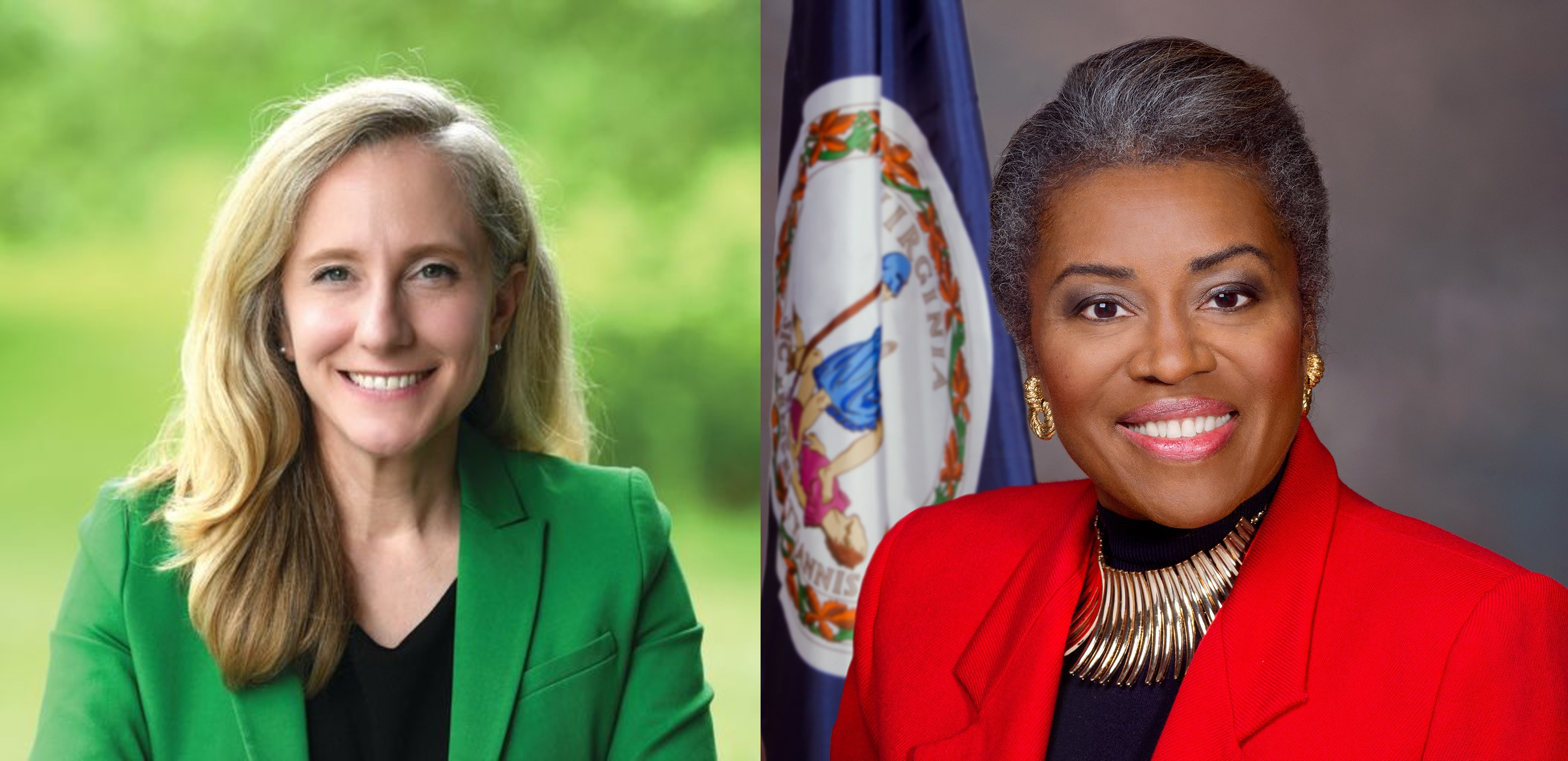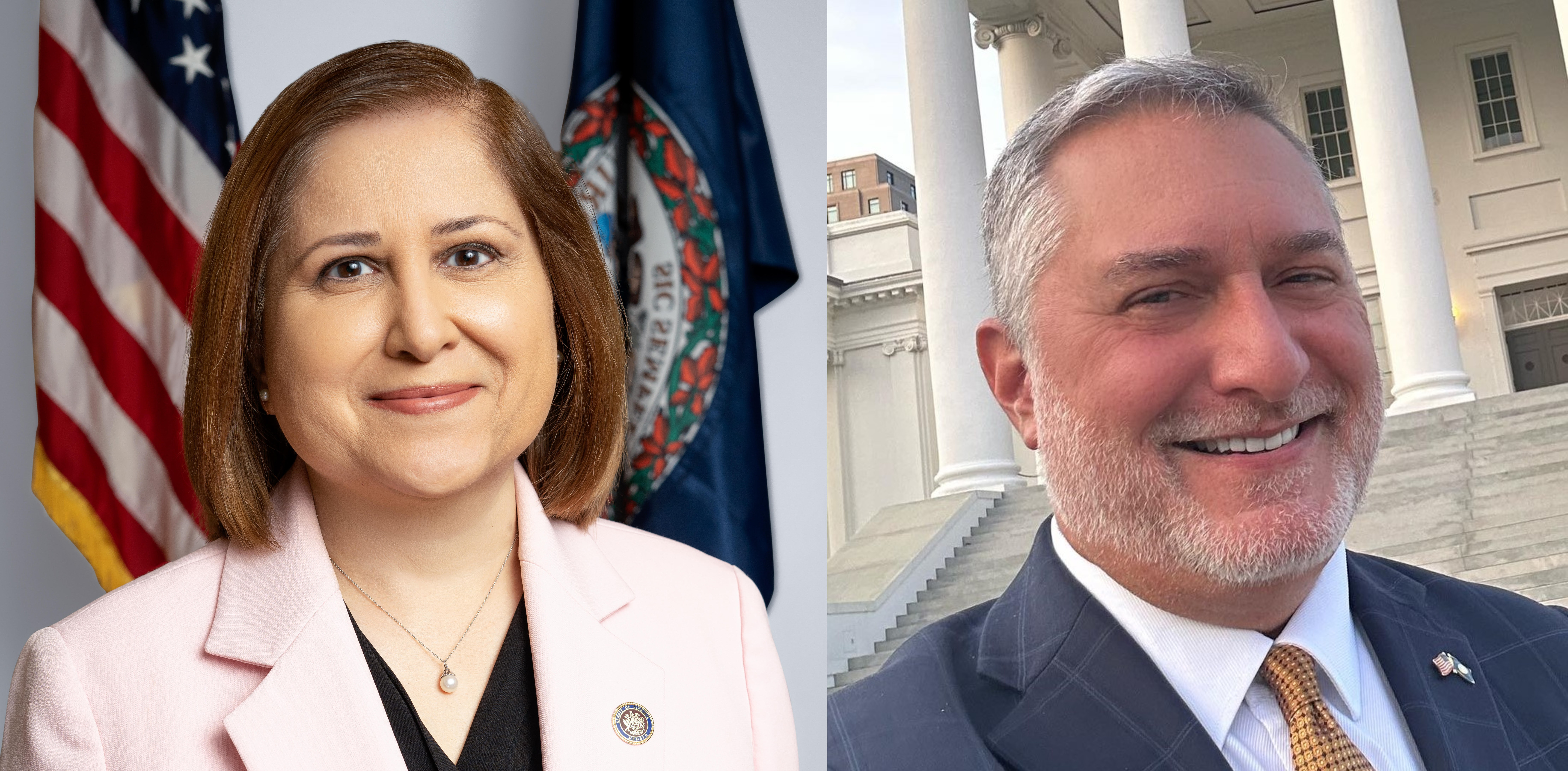Two and a half months before voting begins to pick Virginia’s next governor, Democrat Abigail Spanberer has more than three times as much campaign cash as Republican Winsome Earle-Sears — an advantage that may be unprecedented in modern times.
Spanberger’s financial dominance is part of a larger pattern emerging in the 2025 campaign, in which Democrats are building big cash leads in many races that ought to be competitive.
In the lieutenant governor’s race, Democrat Ghazala Hashmi has almost eight times as much cash on hand as Republican John Reid — even after spending money to win last month’s primary.
House Democrats have more money in hand than Republicans as the two parties bid for all 100 seats in the House of Delegates, where Democrats currently hold a 51-49 advantage. When we look at specific races, Democratic challengers have more cash on hand than Republicans in seven GOP-held districts, while no Republican challenger has an advantage over any Democratic incumbents. In some of those districts, the Democratic financial advantage is several orders of magnitude.
In House District 41 in Montgomery and Roanoke counties, Democrat Lily Franklin has more than twice as much cash on hand than Del. Chris Obenshain, R-Montgomery County.
In House District 82 in the Petersburg area, Democrat Kimberly Pope Adams has nearly three times as much cash as Del. Kim Taylor, R-Petersburg.
The most prominent exception to this decided Democratic financial advantage is in the attorney general’s race, where Republican incumbent Jason Miyares has more than 5.5 times as much cash on hand as Democratic challenger Jay Jones.
All these are new figures from the most recent round of campaign finance reports that were filed this week. Before we delve deeper into these numbers, I’ll deliver my usual caveat about campaign fundraising: Money isn’t everything. Candidates don’t need more money than their opponents, they need enough money to get their message out — and hope it’s a winning one. We can point to the recent Democratic primary as an example: Hashmi didn’t have the most money, but she got the most votes. However, the financial gap between her and opponents wasn’t as great as what we’re seeing here, so these are worrisome figures for Republicans. Now let’s dive in.
Governor: Spanberger vs. Earle-Sears

There are many ways to measure campaign money, each of them valid in their own way.
We can look at the total amount raised over the course of the campaign, which speaks to overall fundraising prowess:
Spanberger: $23,460,823
Earle-Sears: $11,591,853
We can look at the total amount raised in the most recent reporting period, which ran from June 6 to June 30. This helps capture momentum, and whether someone is pulling away or closing the gap:
Spanberger: $4,258,049
Earle-Sears: $2,393,139
Or we can look at who has the most cash on hand:
Spanberger: $15,225,448
Earle-Sears: $4,554,273
Of all these measures available, I usually like this one the best, particularly at this stage of the campaign before heavy advertising begins. We never know how much money a candidate has raised and squandered and how much was wisely spent. However, how much money a campaign has sitting in the bank that could be used going forward seems a more objective measure to me because whatever has been done up until now, all that money could be used wisely. Using cash on hand as the measure also helps make it easier to compare campaigns. The Democratic candidates for lieutenant governor and attorney general had to raise and spend money to win their nominations in primaries; citing those tallies might make their campaigns seem richer than they are since some of that money is already gone. What really seems to matter is not how much Hashmi and Jones raised up until now but how much they have in the bank going forward. That’s why cash on hand is the metric I’m citing today.
About our Voter Guide
We are in the process of revamping our Voter Guide for the fall campaigns. Here’s where things stand:
Governor, lieutenant governor, attorney general: We sent questionnaires to the statewide candidates in May; we’ve already posted their answers (some haven’t replied despite multiple requests). You can find those here.
House of Delegates: We’ve also sent questionnaires to all the House candidates across the state. We’ll post those answers in August (we have to build out some additional parts of the site first).
Local candidates: Finally, we’ve sent questionnaires to all the local candidates in Southwest and Southside. We’ll also post those answers in August.
Advisory to candidates: We sent the questionnaire to the official email address on file with the State Board of Elections. If you didn’t receive one, check your spam folder. If it’s still not there, let us know at elections@cardinalnews.org.
What we see here is that at the end of June, Spanberger had almost 3.4 times as much cash as Earle-Sears — with a gap of $10.6 million. To make that up, Earle-Sears would have to raise almost as much as she has in the entire campaign — and hope Spanberger didn’t add a penny more.
How unusual is this kind of deficit? Let’s find out.
The Virginia Public Access Project, a nonpartisan, nonprofit site that tracks campaign contributions, has digital records on governor’s races doing back to 1997, so this is the eighth gubernatorial cycle for which we have easily accessible data (before then, we’d have to dig through paper records stored somewhere in Richmond). The catch is that VPAP’s data shows total amount raised; figuring out the cash on hand at any particular point in those previous campaigns is harder to suss out.
Here’s what we can say for certain, though: Spanberger has raised slightly more than twice as much overall as Earle-Sears. In none of the previous seven campaigns in VPAP’s database have we had a campaign where the fundraising was that imbalanced. A few have come close — most notably in 2001, when Democrat Mark Warner raised 1.8 times as much as Republican Mark Earley — but none have crossed the “twice as much” threshold. Until now. Maybe that won’t hold, but that’s where we are now. Warner outspent Earley by $8.87 million, but $4.57 million of that was Warner’s own money, according to the VPAP records. What makes Spanberer’s fundraising haul more impressive is that she’s not a multimillionaire who is putting millions of her own money into the campaign. Instead, she’s built a fundraising machine.
Some years Democrats have outraised Republicans and some years Republicans have outraised Democrats. Some years — such as 2021 — the numbers were pretty even. This year they’re not, so the scale of what we’re seeing here so far is not something we’ve seen before.
The good news for Republicans: There’s nothing wrong here that some big checks won’t solve.
The bad news for Republicans: Sometimes money dries up if donors don’t think their money will do any good, so one question out of these campaign finance reports is whether Spanberger’s big money lead will encourage more Republican donations or discourage them.
Also, some money isn’t ideological, it’s practical. Let’s take the mythical but powerful turnip lobby, or Big Turnip, as critics might call it. The turnip barons may prefer a Republican governor because they’re more in sync with Republican positions on minimum wage (don’t raise it) and regulations (the fewer, the better). However, if the turnip barons sense that the Democrat is going to win, they may want to withhold their donations to the Republican candidate and send some money the Democrat’s way because ultimately they want to have the ear of a Democratic governor when it comes time to make appointments to the Turnip Rules and Regulations Board. How many industry groups are looking at these campaign finance reports and reappraising how they want to spend their money to influence state government?
Lieutenant governor: Hashmi vs. Reid

For reasons we can only speculate about, Republican donors are not getting behind GOP lieutenant governor candidate John Reid. Is it because he’s gay? Is it because they don’t know him well? Is it because Reid may not have much of a fundraising mechanism? Is it because — well, who knows?
Here’s what we do know. At the end of June, Hashmi had more than eight times as much cash on hand as Reid — even though she had to spend a lot of her money to win a six-way primary.
Hashmi: $1,278,085
Reid: $163,082
Here’s how paltry Reid’s bank account is: There are 28 House of Delegates candidates who have more money than he does. In House District 30 in Fauquier and Loudoun counties, both candidates (Republican incumbent Geary Higgins and Democratic challenger John McAuliff) have more money in the bank. Ditto for House District 71 in the Williamsburg area (Republican incumbent Amanda Batten and Democratic challenger Jessica Anderson).
Reid needs more money if he’s going to run a serious statewide campaign.
Attorney general: Jones vs. Miyares

This is the bright spot for Republicans. Overall, Jones has raised more than Miyares ($9,797,136 to $9,016,558) but Jones had to spend most of his money to win the Democratic primary while Miyares didn’t face opposition for renomination. At the end of June, here’s how their bank accounts stood:
Miyares: $6,950,752
Jones: $1,238,826
A question I’ve already heard some Republicans start to whisper: If they can’t win the top two spots, what do they need to do to save Miyares? Some Republican donors may conclude Miyares is a better investment.
House of Delegates
It’s clear that Democratic donors have learned some lessons. Two years ago, they didn’t put much money into the campaigns of Lily Franklin in House District 41 and Jessica Anderson in House District 71, yet both candidates came close to winning anyway. This year both are running again, and this time Democratic donors are pouring money into those campaigns.
Franklin, as we’ve seen, has a big financial advantage over Obenshain. The Anderson-Batten race is more even (Anderson has $280,004, Batten $271,950), but both represent big changes from the last cycle.
After the primary, House Democrats identified 13 Republican-held districts that are their official “targeted” districts. In six of those, the Democratic challenger has more cash on hand than the Republican. Here are those targeted districts and the cash on hand, with the leader shown in bold: DISTRICT (general area) DEMOCRATIC CHALLENGER REPUBLICAN INCUMBENT HD 22 (Prince William) Elizabeth Guzman $273,445 Ian Lovejoy $149,292 HD 30 (Fauquier, Loudoun) John Chilton McAuliff $298,691 Geary Higgins $250,346 HD 41 (Montomery, Roanoke Co.) Lily Franklin $380,203 Chris Obenshain $155,069 HD 57 (Henrico, Goochland) May Nivar $128,524 David Owen $198,545 HD 64 (Stafford) Stacey Annie Carroll $73,732 Paul Milde $147,417 HD 66 (Spotsylvania, Caroline) Nicole Cole $127,267 Bobby Orrock $261,021 HD 69 (York, Gloucester, James City, Newport News) Mark Downey $69,964 Chad Green $98,221 HD 71 (James City, Williamsburg, New Kent) Jessica Anderson $280,004 Amanda Batten $271,950 HD 73 (Chesterfield) Leslie Mehta $85,393 Mark Earley, Jr. $112,434 HD 75 (Chesterfield, Hopewell, Prince George) Lindsey Dougherty $49,552 Carrie Coyner $384,409 HD 82 (Petersburg, Dinwiddie, Prince Geore, Surry) Kimberly Pope Adams $347,020 Kim Taylor $122,960 HD 86 (Hampton, York, Poquoson) Virgil Gene Thornton, Sr $82,720 A.C. Cordoza $74,474 HD 89* (Chesapeake, Suffolk) Karen Robins Carnegie $61,095 Mike Lamonea* $92,041
* Note: House District 89 is a Republican-held seat, but the incumbent is retiring, so Lamonea is a first-time candidate.
In a seventh district not listed as an official target, the Democrat has more money than the incumbent: In House District 62 in the Piedmont, Democrat Sara Ratliffe has $25,515 to $9,972 for Republican Karen Hamilton. One mitigating factor: Hamilton had to spend money to win her primary; Ratliffe didn’t, and this is still a district that votes about 60% Republican, according to election records compiled by VPAP.
It’s unclear how many Democratic-held districts Republicans have officially targeted, but there are four seats that Democrats won by narrow margins last time. In three of those, the Democratic candidates have more money; in the fourth, it’s unclear because one candidate apparently hasn’t filed yet.
Once again, money doesn’t always translate into votes and not a single vote has yet to be cast. However, lots of dollars have been, and this is the way they’re trending.
If all this talk of campaign cash is leaving you queasy, here’s a gentle reminder that you can donate to us to help us cover these campaigns. You can also sign up for our weekly political newsletter, West of the Capital, that goes out on Friday afternoons:



